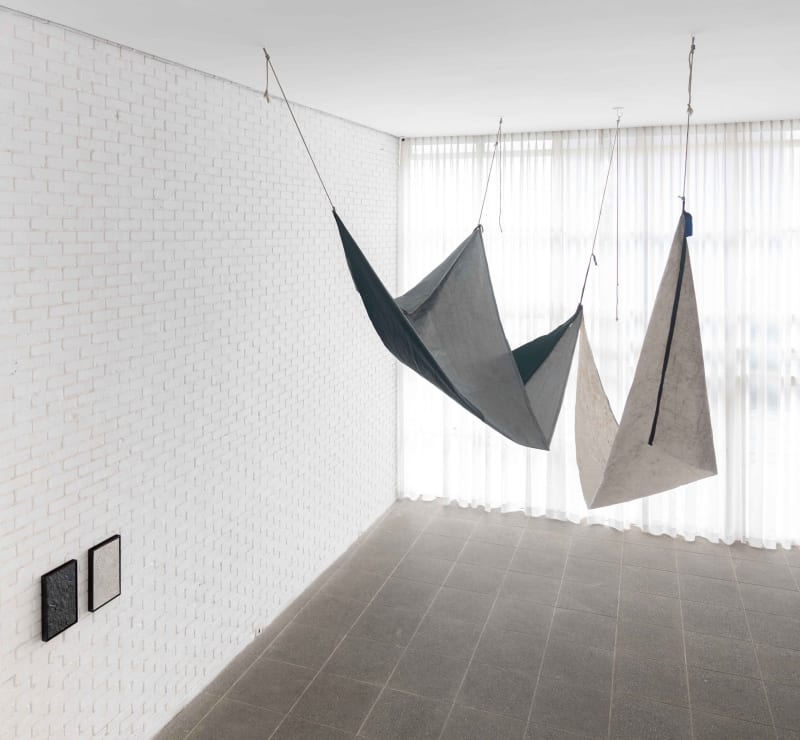NOVO BALANÇO
Allan Weber (Rio de Janeiro, 1992) presents the series Novo Balanço on the mezzanine of the IAB – Brazilian Institute of Architects, showcasing recent developments in his exploration of the tarps commonly used in funk parties. The new series highlights the artist's ongoing exploration and deepening investigation into materials, chromatic studies, supports, and their interactions with the architectural contexts of the spaces housing these works, revealing a continuous expansion.
Since his debut solo exhibition Existe uma vida inteira que tu não conhece [There’s a Whole Life You Don’t Know] (2020), the artist has consistently broadened access to his universe, bringing us closer to his place of origin and his community, which serves as the central foundation for his references, inspiring and permeating his provocative aesthetic maneuvers.
Allan's research advances through social, geopolitical, and symbolic issues, propelling his artistic journey to question and confront the stigmas of historically marginalized spaces. While contemporary Brazilian history often portrays peripheries as zones marked by violence and subversion, Weber, born and raised in the 5 Bocas favela in Rio de Janeiro, continues to challenge this narrative by identifying in these spaces the concepts, craftsmanship, codes, and technologies that aesthetically impact and inform his practice.
In this context, the tarpaulin emerges as the interface and materiality for experiments in his expanded paintings, sculptures, installations, and site-specific works, giving meaning and outline to his research, which gains breadth in both thought and execution. Tarps play an inherent role in the dynamics of circuses, public events, and street parties, where their use commonly serves the purpose of protecting the public from the elements or acting simply as a structural and aesthetic element. Weber reconfigures their meaning by elevating the tarps as a central element, a protagonist, and the creative surface for his poetics.
The artist's practice, particularly the works comprising this new series, establishes connections with Brazilian art history by exploring intersections with the Concrete and Neoconcrete movements. Known for their pursuit of innovation and avant-gardism, both movements challenged the prevailing aesthetic and conceptual conventions of their time, introducing new forms of expression within social contexts. Weber's work serves as a reminder of this legacy, amplifying the reverberations of their pursuit of authenticity and new artistic modes.
On the walls, the interplay of colors and the use of monochrome represent a departure from the usual color standards found in tarpaulin, instead embracing a chromatic intensity that shapes the composition of forms on the surface. This is evident in the uniform color schemes and geometric variations.
In the exhibition space, the tarps lay denser on the floor, tied together, suggesting either something unfolding or about to bid farewell, while creating dichotomies to be discovered. This sharpens narratives and curiosities around the phenomenology of the material itself and its polysemy of meaning.
In contrast, the site-specific works called Passinhos choreograph with the suspended tarps, creating movement above our heads and among the vertices of the symbolic modern architecture designed by Rino Levi. Through varying scales, they redirect our gaze, overlapping lines, curves, and volumes to craft multiple compositions in space.
Allan Weber: Novo Balanço invites viewers to engage in an immersive experience, offering not only observation but also interaction with the tarps. They encourage us to walk, move around, and shift our gaze among them, exploring their textures and shapes. This encounter with the exhibited materials deepens our appreciation of the physical and conceptual nuances present within the space. The exhibition also seeks to connect with the essence of the streets, their symbolic elements, and the complexities of urban life. In doing so, it transcends the boundaries between the ordinary and the extraordinary, illuminating the intersections between art, gesture, and aesthetic arrangements, while significantly echoing its social and political implications.
Jean Carlos Azuos


![Allan Weber, Passinhos, da série Novo Balanço [Passinhos, from the series Novo Balanço], 2024](https://artlogic-res.cloudinary.com/w_1600,h_1600,c_limit,f_auto,fl_lossy,q_auto/artlogicstorage/antoniabergamin/images/view/c6ee4243b65522507bb16b7efa0ee177j/galatea-allan-weber-passinhos-da-s-rie-novo-balan-o-passinhos-from-the-series-novo-balan-o-2024.jpg)
![Allan Weber, Sem título, da série Novo Balanço [Untitled, from the series Novo Balanço], 2024](https://artlogic-res.cloudinary.com/w_1600,h_1600,c_limit,f_auto,fl_lossy,q_auto/artlogicstorage/antoniabergamin/images/view/237d3307c4afacd3c051519e51f0e9fap/galatea-allan-weber-sem-t-tulo-da-s-rie-novo-balan-o-untitled-from-the-series-novo-balan-o-2024.png)
![Allan Weber, Sem título, da série Novo Balanço [Untitled, from the series Novo Balanço], 2024](https://artlogic-res.cloudinary.com/w_1600,h_1600,c_limit,f_auto,fl_lossy,q_auto/artlogicstorage/antoniabergamin/images/view/bf0224918da8839176364ef691580d09p/galatea-allan-weber-sem-t-tulo-da-s-rie-novo-balan-o-untitled-from-the-series-novo-balan-o-2024.png)
![Allan Weber, Sem título [Untitled], da série [from the series] Dia de Baile, 2024](https://artlogic-res.cloudinary.com/w_1600,h_1600,c_limit,f_auto,fl_lossy,q_auto/artlogicstorage/antoniabergamin/images/view/4eaaeedbf6cf34ede60915addfdf1458p/galatea-allan-weber-sem-t-tulo-untitled-da-s-rie-from-the-series-dia-de-baile-2024.png)
![Allan Weber, Sem título [Untitled], da série [from the series] Novo balanço, 2024](https://artlogic-res.cloudinary.com/w_1600,h_1600,c_limit,f_auto,fl_lossy,q_auto/artlogicstorage/antoniabergamin/images/view/76aa4a48e0c1433260a97ff8de53f19fp/galatea-allan-weber-sem-t-tulo-untitled-da-s-rie-from-the-series-novo-balan-o-2024.png)

